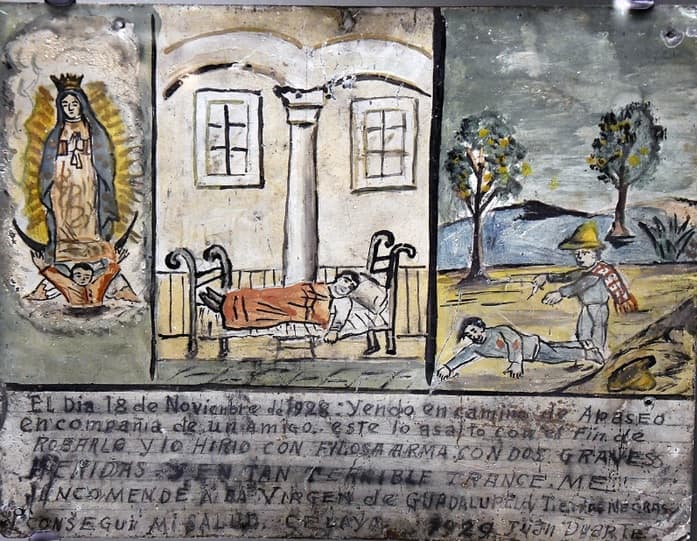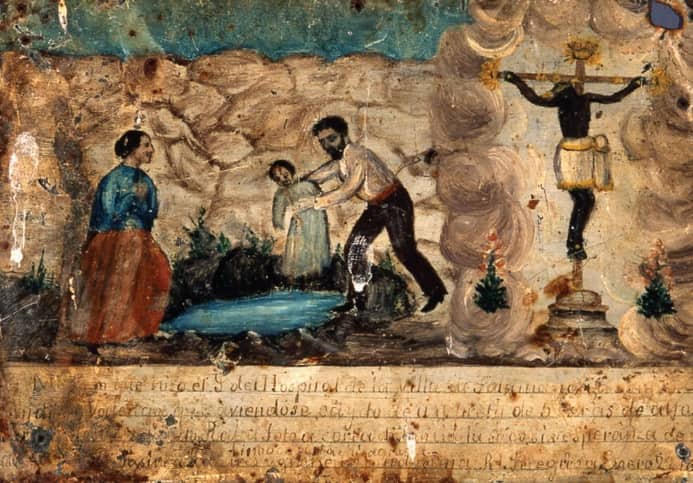Ex-votos; the manifestation of faith in the popular culture
The ex-votos not only have a religious value given by the believers, but they are works that account for the history, organization, and beliefs of a society.

The word ex-voto comes from the Latin "ex voto", which means "from a vow"; that is, something that is promised to be done when a favor is fulfilled or received. Not only do ex-votos have a religious significance attributed to them by the faithful, but they are also works that give an account of the history, organization, and beliefs of a society.
It is near 1890 and a Mexican family suffers misfortune, a little girl has fallen from a five-star parapet and was rescued by a man, her health is delicate and the sadness and grief seizes her closest ones. This is the tragedy of that family, or at least that is what we can understand from the pictographic language and the history narrated in a text that due to the ravages of time is almost unreadable. This misfortune has been recovered from an image painted in oil 129 years ago, it is an ex-voto that is part of the collection of the Amparo Museum in Puebla.
But the tragedy has not been shaped for free, art is the embodiment of a promise, is the payment for a miracle granted, is an offering in gratitude for a wonder fulfilled by a saint or divine figure of Catholicism. In this case, it is a miracle granted by the Lord of the Hospital for the benefit of the girl who, on the verge of dying, was healed by "divine providence" and the efforts of her relatives.
The altarpiece shows how the Lord of the Hospital witnesses the misfortune and at the bottom of the scene, with a letter that was once intelligible, the feat of this religious figure is described.

The word ex-voto comes from the Latin "ex voto", which means "from a vow"; that is, something that is promised to be done when a favor is fulfilled or received. Ex-votos have been present in all cultures and take different forms depending on the religious characteristics of each one of them, they can be dances, rituals, donations, prayers, or other types of acts.
According to Clara Bargellini Cioni, a researcher at the Institute of Aesthetic Research at UNAM, ex-votos represent an exchange between the earthly and the sacred: "(The ex-votos) not only express gratitude for a unique and singular event; they also seek to strengthen the relationship and communication between the human and the divine in such a way that it extends in effectiveness and duration over time, as well as to spread the importance of that relationship among those who come to know its benefits".
In other words, the function of the ex-voto, beyond fulfilling a promise and giving thanks, is to strengthen and spread religious feelings.
Within the framework of Catholicism, ex-votos show the need to tell or reveal the stories of these miracles; therefore, in addition to pictorial representations through painting, these paintings include a brief narrative of the events, prayers, and the alleged miracle that motivated the realization of the piece.
This kind of ex-votos arises in Italy in the 15th century and are characterized by capturing the unexpected in the lives of believers: the unexpected manifests itself in tragedies such as pain, danger, risk of death, illness, accidents, injustice, and other vicissitudes; at the same time they form a testimony of faith and give an account of how believers responded to adversity, attributing to a superior force the ability to change the course of their lives.
According to Bargellini Cioni, the practice of depositing these pieces in religious precincts spread throughout Europe and reached New Spain. By the 19th century these altarpieces continued to be made and by the 20th century, they began to attract the attention of artists and collectors because they were popular artistic expressions registered outside of the academy and the dominant techniques.
Generally, the paintings that make up the votive offerings are made in oil on sheet metal or wood and their authors are unknown; however, some are signed or are attributed to an author based on the style or technique used for their realization.
The interest in these expressions of popular art influenced diverse artists of the 20th century, who produced pieces that emulated the ex-votos, but that was outside the religious or sacred context and that on the contrary sought to reflect diverse aspects of social and daily life.
The ex-votos not only have religious importance determined by the believers who inspired their creation, but they are also cultural and historical pieces that show the popular artistic expressions and the history, organization, and beliefs of a society.
Source: Ministry of Culture




